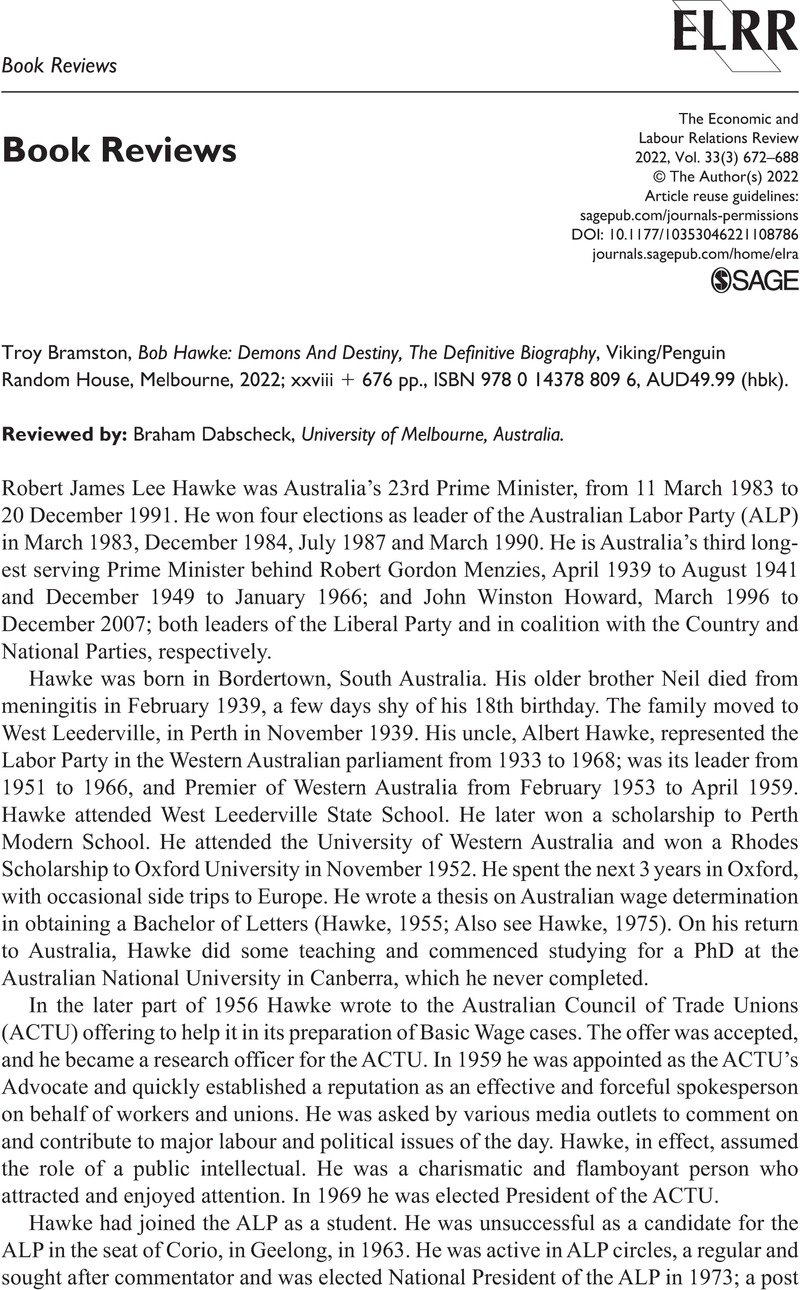No CrossRef data available.
Article contents
Troy Bramston, Bob Hawke: Demons And Destiny, The Definitive Biography, Viking/Penguin Random House, Melbourne, 2022; xxviii + 676 pp., ISBN 978 0 14378 809 6, AUD49.99 (hbk).
Review products
Troy Bramston, Bob Hawke: Demons And Destiny, The Definitive Biography, Viking/Penguin Random House, Melbourne, 2022; xxviii + 676 pp., ISBN 978 0 14378 809 6, AUD49.99 (hbk).
Published online by Cambridge University Press: 01 January 2023
Abstract
An abstract is not available for this content so a preview has been provided. Please use the Get access link above for information on how to access this content.

- Type
- Book Reviews
- Information
- Copyright
- Copyright © The Author(s) 2022
References
Australian Bureau of Statistics [ABS] (1994) The Labour Force, Australia. Canberra, ACT: Cat. No. 6203.0.Google Scholar
Australian Bureau of Statistics [ABS] (1995) Weekly Earnings of Employees (Distribution). Canberra, ACT: Product No. 6310-0-40-001.Google Scholar
Australian Bureau of Statistics [ABS] (1996a) Trade Union Members, Australia. Canberra, ACT: Cat. No. 6325.0.Google Scholar
Australian Bureau of Statistics [ABS] (1996b) Trade Union Statistics, Australia, Canberra, Cat. No. 6323.0.Google Scholar
Bell, R (2022) Playing with Apartheid: Racism, Australia, Sport and South Africa. Melbourne, VIC: Australian Scholarly Publishing.Google Scholar
Coventry, C (2021) The ‘eloquence’ of Robert J Hawke: United States informer. Australian Journal of Politics and History 67(1): 67–87.CrossRefGoogle Scholar
Dabscheck, B (1975) The 1975 National Wage Case: Now we have an incomes policy. The Journal of Industrial Relations 17(3): 298–310.CrossRefGoogle Scholar
Dabscheck, B (1989) Australian Industrial Relations in the 1980s. Melbourne, VIC: Oxford University Press.Google Scholar
Dabscheck, B (1995) The Struggle for Australian Industrial Relations. Melbourne, VIC: Oxford University Press.Google Scholar
Hawke, RJL (1955) An appraisal of the role of the Australian Commonwealth Court of Conciliation and Arbitration with special reference to the development of the concept of a Basic Wage. Bachelor of Letters thesis, December. Oxford: University of Oxford.Google Scholar
Hawke, RJ (1975) The growth of the Court’s authority. In: Niland, JR and Isaac, JE (eds.) Australian Labour Economics Readings, New Edition. Melbourne, VIC: Sun Books, pp. 16–48.Google Scholar
Murray, R (1970) The Split: Australian Labor in the Fifties. Melbourne, VIC: Cheshire.Google Scholar
National Economic Summit Conference (1983) Documents and Proceedings, Volume 2, Record of Proceedings. Canberra, ACT: Australian Government Publishing Service.Google Scholar
National Taxation Summit (1985) Record of Proceedings. Canberra, ACT: Australian Government Publishing Service.Google Scholar
National Wage Case (1975) Minimum Wage and National Wage Case, 30 April 1975. 167 CAR 18.Google Scholar
Santamaria, BA (1981) Santamaria: Against the Tide, Melbourne, VIC: Oxford University Press.Google Scholar
Wilson, K, Bradford, J and Fitzpatrick, M (eds) (2000) Australia in Accord: An Evaluation of the Prices and Incomes Accord in the Hawke-Keating Years. Footscray: South Pacific Publishing, pp. 283–406.Google Scholar


